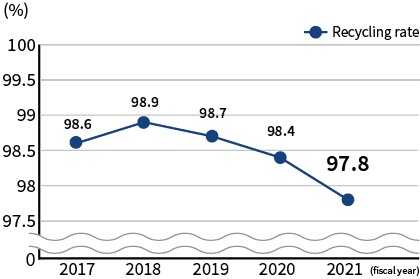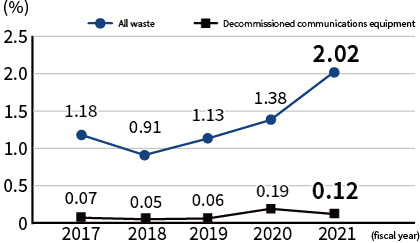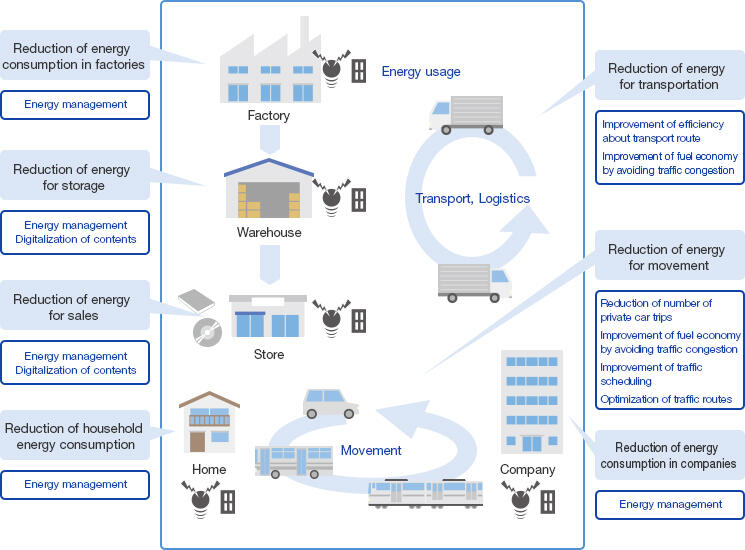Microsoft ends support for Internet Explorer on June 16, 2022.
We recommend using one of the browsers listed below.
- Microsoft Edge(Latest version)
- Mozilla Firefox(Latest version)
- Google Chrome(Latest version)
- Apple Safari(Latest version)
Please contact your browser provider for download and installation instructions.
Progress on environmental targets
Reduction of Greenhouse Gas Emissions across Society
The NTT Group has established a target for fiscal 2030 calling for it to contribute to reducing greenhouse gas emissions of society as a whole by at least 10 times more than the NTT Group's own emissions through its services and technologies.
This target is intended to contribute to the reduction of greenhouse gas emissions across society by providing ICT services and technologies while curbing greenhouse gas emission amounts from our own business activities.

The use of information communication, which is expanding each year through the spread of smartphones and high-speed and large-capacity networks, requires energy. On the other hand, by improving efficiency and reduction of goods through digitalization, the use of information also contributes to the reduction of greenhouse gas emissions across society by reducing environmental load more than the energy consumption it requires.
*The reduction of greenhouse gas emissions across society quantifies the energy savings effects obtained through ICT services using CO2 volume. The energy saving effect is quantified with references to the Telecommunication Technology Committee (TTC) Standard "Methodology for the assessment of the environmental impact of information and communication technology goods, networks and services (JT-L1410)" and the calculation method specified by the "LCA of Information and Communication Technology (ICT) business organizations" research group of the Life Cycle Assessment Society of Japan.
*The effects of energy savings obtained through the introduction of ICT services include, for example, reduced electricity usage by homes, companies and factories from energy management, alleviation of traffic congestion using analysis of congestion and operation information, and reduced electricity usage from the streamlining and optimization of transportation schedules.
*The amount of greenhouse gas emissions for the NTT Group includes the emissions from facilities necessary for other telecommunication carriers and data centers to provide their services.
Power Efficiency of the Telecommunications Business
The NTT Group has established the target for fiscal 2030 to improve the power efficiency per data transmission in our telecommunications business to at least 10 times higher than in fiscal 2013*1. Electricity is essential to the continuity of the telecommunications business and it also accounts for more than 90% of the NTT Group's greenhouse gas emissions. We set this target because improving the efficiency of using electricity both reduces the risk of business disruptions and helps mitigate climate change.
We are introducing highly energy efficient equipment and improving the efficiency of network structures based on the NTT Group Green Procurement Standards.
In October 2018, NTT became the first telecommunications carrier in Japan to join the EP100*2 international initiative on energy efficiency led by The Climate Group. By participating in such an international initiative, we intend to publicly declare the NTT Group's commitment to the environment and express our stance on international environmental issues.
 Power Efficiency of the Telecommunications Business
Power Efficiency of the Telecommunications Business
*1.Power efficiency per data transmission in our telecommunications business covers the domestic operations of five companies: NTT East, NTT West, NTT Communications, NTT DOCOMO, and NTT DATA
*2.An international initiative comprising companies pledging to double the energy efficiency of their operations (improve energy efficiency by 50%) as participants.
Adaptation to climate change
The NTT Group is moving forward with initiatives for the adaptation of the NTT Group and of society to play our part in adapting to climate change, and in developing and disseminating examples of adaptation.
Final disposal ratio and recycling rate of waste
The NTT Group has established a target for achieving a 99% or higher recycling rate of disposed waste generated by the NTT Group by fiscal 2030. We require a large amount of resources in order to sustain our business operations and provide various services including information communication. This is why we have set a target to contribute to both the avoidance of business continuity risks and achievement of closed loop recycling.
In fiscal 2021, the recycling rate of disposed waste was 97.8%. We will continue to work hard to promote the 3Rs toward our goal of 99% or higher.
Regarding decommissioned telecommunications equipment, we have achieved zero emissions (1% or lower final disposal ratio of waste) for 18 consecutive years since fiscal 2004.
 Recycling Rate
Recycling Rate
 Final Disposal Ratio
Final Disposal Ratio
Initiatives to preserve the ecosystem
To contribute to preservation of the ecosystem, the NTT Group is also working on business activities considerate of ecosystem and contribution activities to ecosystem preservation, aiming to develop and disseminate examples of activities.
Concept and calculating method of energy saving effect
Energy saving effect
ICT contributes to the reduction of environmental load in daily lives and society by, for example, converting books, music, movies, and others into digital contents (dematerialization), not only dispensing with actual books, CDs, and DVDs, but also substituting the movement of people and goods (movement substitution), and also by improving the efficiency of living and work.
Before fiscal 2017, based on the concept of Green by ICT, which was promoted under THE GREEN VISION 2020, the NTT Group converted the amount of reduced environmental load to a CO2 amount for all of these effects (dematerialization, movement substitution, and efficiency improvement).
Under the environmental targets, we set and manage the scope of target setting and performance management of the reduction of greenhouse gas emissions across society with the CO2 conversion equivalent for the "energy saving effect" of providing our services and technologies.
This was because, as stated in the NTT Group's Environment and Energy Vision, in working to resolve various environmental issues, we intended not only to measure the contribution to the environmental protection from the CO2 amount related to climate change, but also to measure and introduce contribution to environmental protection in an easier-to-understand way in various fields. For example, regarding dematerialization, we will not convert the reduction amount of resources such as paper into CO2 amount, but present the reduction amount of paper itself.
 Example of energy saving effect
Example of energy saving effect
 Effects of Green by ICT and energy saving
Effects of Green by ICT and energy saving
This is a comparison between the calculation result of the total effect of Green by ICT as with before fiscal 2016 (left: estimated value) and the calculation result of the energy saving effect only (right).
Calculating method of energy saving effect
The same as before, the calculation is based on the Telecommunication Technology Committee (TTC) Standard "Methodology for the assessment of the environmental impact of information and communication technology goods, networks and services (JT-L1410)."
The TTC Standard JT-L1410 standardizes how to quantify the "environmental load reduction achieved by ICT" and "environmental load caused by ICT", and calculates the environmental load reduction effect, including the increase in energy required for using ICT.
The TTC Standard JT-L1410 specifies the following eight items as activities related to ICT goods, networks, and services.
| Activity | Subjects | |
|---|---|---|
| 1 | ICT hardware | Resources and energy for manufacturing, use, and disposal of ICT equipment |
| 2 | NW infrastructure | Resources and energy for manufacturing, use, and disposal of NW infrastructure |
| 3 | ICT software | Resources and energy for manufacturing, use, and disposal of software |
| 4 | Movement of people | Materials and energy required for the movement of people |
| 5 | Movement of goods | Materials and energy required for the movement of things |
| 6 | Material and energy consumption | Materials and energy input and output to and from products and systems |
| 7 | Storage of goods | Materials and energy required for the storage of goods |
| 8 | Working environment | Materials and energy required for people to work in offices, etc. |
Regarding these activities, we have considered all the effects of dematerialization, movement substitution, and efficiency improvement so far. In calculating the energy saving effect, we calculate the amount of energy that can be reduced mainly by movement substitution and efficiency improvement.
*As for moving substitution, we calculate the effect of reduction of private car use, improvement of delivery efficiency, and others, excluding the decreased opportunities for using public transportation.
Environmental data
NTT Group Environmental Activities
NTT STORY
WEB media that thinks about the future with NTT










